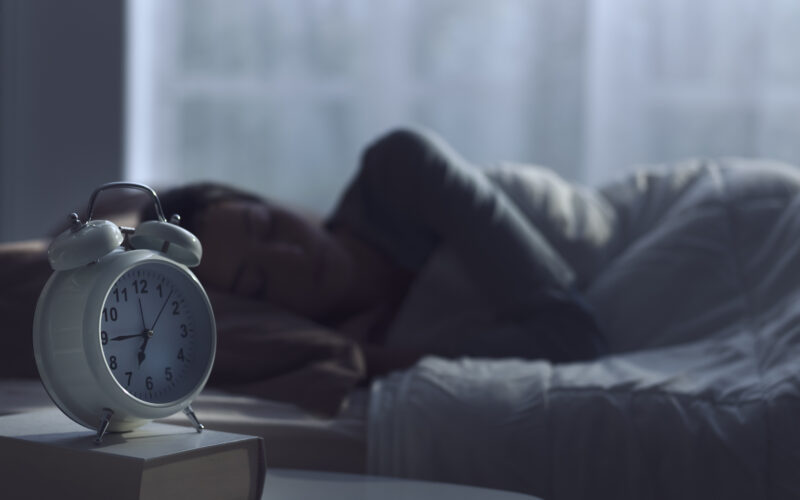You have probably heard the terms “circadian clock” or “circadian rhythm,” but you may not know exactly what they mean. Perhaps you imagine a circadian clock as something like a wristwatch—or more accurately, a Fitbit—that resides somewhere in the depths of your body. Maybe below the heart, above the liver. But it’s a little more complicated than that, and what you don’t know about your circadian rhythm could be affecting your fertility.
Each individual cell—all 37.2 trillion of them!—has its own molecular circadian clock that consists of interlocked transcriptional/translational feedback loops of oscillation periods that almost perfectly line up with 24 hours. Research shows that circadian clocks in the ovarian cells play a big role in the timing of ovulation—that means that even the activity of your ovaries is in response to an internal clock.
The circadian rhythm and fertility hormones
While each individual cell has its own circadian clock, there is a central circadian clock that is localized in the brain, which keeps all the other clocks running on schedule. The “Big Ben” central clock of your body is located in the suprachiasmatic nucleus (SCN), a tiny region of the brain located within the hypothalamus.
Here’s how this part of the brain affects women’s hormones. The hypothalamus plays a major role in the timing and production of gonadotropin-releasing hormone (GnRH), which is the hormone that tells the pituitary gland (which is also located within the brain) to make follicle stimulating hormone (FSH). And FSH is the hormone responsible for telling the ovaries that it’s time to kick off a new cycle.
The luteinizing hormone (LH) surge is the final hormonal action in the cascade of events that cause ovulation—the pivotal event of the menstrual cycle. After the pituitary gland sends the surge of LH, an egg is released from an ovary 24-36 hours later.
According to a 2016 article [1], “The first evidence of circadian control of ovulation was more than 50 years ago by [Dr. John Everett and Dr. Charles Sawyer] who found the LH surge was always witnessed in the afternoon in female rats [2].” In that same study, it was found that when LH suppressants were given, the LH surge didn’t occur until a full 24 hours later, long after the suppressants had worn off.
This close connection between the pituitary gland, the hypothalamus, and the ovaries, is what is known as the hypothalamic-pituitary-gonadal (HPG) axis. You can think of the HPG axis as the cell towers that allow your iPhone to call your friend clear across the country; the HPG axis sends and receives signals from the brain to the ovaries. Notably, circadian clock gene expression has been observed in the HPG axis.
What a desynchronized circadian rhythm can mean for your fertility
What does the science on ovaries and the circadian clock mean for you and your cycle? The main takeaway here is that any bump in the road is going to have a cascade effect on the whole cycle. These complex connections are still being studied, but given evidence in mice with abnormal (or “mutant”) SCN and irregular cycles [2], it’s probable that a disruption in a human woman’s circadian rhythm could mean reduced, altered, or impaired fertility and fecundity.
Disrupted coordination and synchronization of circadian clocks in the brain have been linked with infertility [1], cancer risk, sleep and mood disorders, and even the incidence of digestive disorders [3]. Common hormonal disorders like Polycystic Ovary Syndrome (PCOS), endometriosis, and other malignant endocrine tumors are likely caused and/or exacerbated by a desynchronization of circadian clocks in the ovary, uterus, pituitary and hypothalamus gland.
A desynchronization of one’s circadian clock is often accompanied by excessive androgen secretion (due to the HPA, or stress, axis being stimulated) which aggravates existing conditions. Androgens are typically thought of as “male hormones,” as they are present in higher amounts in men, and give men their distinctly male characteristics. In women, excessive androgen secretion runs the gamut of symptoms from annoying to life-altering: symptoms like PMS, excessive hair production, hair loss, depression, acne, high blood pressure, and insulin resistance.
What is causing this desynchronization and how do you stop it? The two biggest factors are light exposure (yup, the cell phone you are probably reading this on) and stress (hint: the thing you are probably procrastinating doing by reading this, but don’t stop reading).
It’s no secret that we are bombarded by both artificial light and stress in our daily lives. While avoiding artificial light is near impossible today, it is possible to bump up your natural light exposure.
Tips to regulate your circadian rhythm—and improve your fertility
Expose yourself to natural light
Getting outside every day (yes, even when the weather is bad, even when it’s raining, even when it’s cold) helps reset those circadian clocks. I lived in Montana for four years, so I can say with confidence that winter doesn’t have to mean staying cooped up inside. Exposure to morning sunlight might be the most beneficial of all, especially in terms of getting your sleep cycle organized. As we enter winter in this strange pandemic season, I sense people will be forced to gather outside to maintain social distance. This could mean that people will be exposed to more natural light this winter than in previous winters, which is great. If you dress appropriately, you can often make it work! But if getting outside just isn’t going to happen for whatever reason, consider a bright light therapy box to use in the morning, especially if you are prone to depression in the winter.
A great source of natural light in the darkness of winter that won’t disrupt your sleep cycle can be a fire. If you have a wood burning fire in your house, pick up some firewood at your local store. You can also use candles. A 2014 paper found that “during the night, light from a fire is very different from that from an electric light: camp fire and candles are far dimmer than electric lighting and the wavelength is strongly skewed toward the red end of the spectrum; as a result, fire-light has much less impact on circadian rhythmicity than electric light.” [4]
Limit your exposure to artificial light (aka screens!)
This one is so, so hard. But it’s worth putting in the effort. Before you go to bed at night, opt for a book instead of social media. Bring back print! Some people will even purposely charge their phone in a separate room at night to be away from it. If you use your phone near your bed for the alarm, consider purchasing a simple alarm clock as an investment in your health, your sleep hygiene, and your relationship. You can even find one that doesn’t emit light!
Plan a rhythm into your day
Schedule a purposeful down time in your day. Make purposeful productive time in your day. We can’t be “on” 24/7, otherwise our system gets overloaded and doesn’t know when it’s time to “turn off.” Tell your brain when you are “out of office.” Keep mealtimes more or less regular. Regular bedtimes and wake time that allow at least 7-8 hours of sleep every night are essential. The process of sufficient sleep at the right time of the circadian rhythm has a tremendous impact on our hormones. Many people will try to ‘burn the candle at both ends’ with a busy lifestyle, but habitually getting less than 7 hours of sleep will activate the stress response, and has been tied to worse reproductive health and even higher mortality rates.
Manage the stress in your life
Which leads me to my next point: I talk about this so much because it’s the most influential thing you can possibly do for your hormonal health. If you can’t eat organic, if you can’t get outside every day, if you can’t buy every single supplement on the shelf—you can manage your reactions to the stressors in your life (sometimes with a little help). This 2017 study concluded that “Upregulation due to acute HPA axis activation or exogenous treatment can have detrimental effects on fertility and fetal outcomes. Elevated HPA activity is associated with altered functions of the hypothalamus, pituitary, and gonads.” [5]
Avoid hormonal birth control
Given the delicate balance of our body’s hormones and circadian rhythm, it’s no surprise that taking the synthetic hormones in birth control can have an effect here as well. Hormonal contraceptives have been shown to alter circadian rhythm parameters of cortisol, melatonin, blood pressure, heart rate, skin blood flow, transepidermal water loss, and skin amino acids of healthy young women. [6] In other words, hormonal contraception can artificially induce a state of stress in the body, which can affect circadian rhythms on a cellular level.
For those seeking to avoid the detrimental effects of birth control, Fertility Awareness Methods are great alternatives, not only for effective family planning, but also for better health and/or endocrine disorder management. Plus, they don’t mess with any of the body’s natural processes!
So, there you have it. Ovarian function seems to be intimately tied to disruption of circadian rhythms, which can exacerbate hormonal dysfunction. By exposing yourself to natural light sources, limiting exposure to artificial light, maintaining a rhythm throughout your day, and managing stress, you can mitigate these effects of circadian desynchronization. Your hormones, your fertility, and your well-being will benefit.
References
[1] Goldstein C, Smith Y. Sleep, Circadian Rhythms, and Fertility. Curr Sleep Med Rep. 2016;2(4):206-217. doi:10.1007/s40675-016-0057-9 [2] Everett J, Sawyer C. A 24-hour periodicity in the “LH-release apparatus” of female rats, disclosed by barbiturate sedation1. Endocrinology. 1950;47(3):198-218. Doi:10.1210/endo-47-3-198 [3] Sellix M, Menaker M. Circadian clocks in the ovary. Trends in Endocrinology & Metabolism. 2010;21(10):628-636. doi:10.1016/j.tem.2010.06.002 [4] Stevens R, Zhu Y. Electric light, particularly at night, disrupts human circadian rhythmicity: is that a problem?. Philosophical Transactions of the Royal Society B: Biological Sciences. 2015;370(1667):20140120. doi:10.1098/rstb.2014.0120 [5] Joseph D, Whirledge S. Stress and the HPA Axis: Balancing Homeostasis and Fertility. Int J Mol Sci. 2017;18(10):2224. doi:10.3390/ijms18102224 [6] Reinberg A, Touitou Y, Soudant É, Bernard D, Bazin R, Mechkouri M. Oral Contraceptives Alter Circadian Rhythm Parameters of Cortisol, Melatonin, Blood Pressure, Heart Rate, Skin Blood Flow, Transepidermal Water Loss, and Skin Amino Acids of Healthy Young Women. Chronobiol Int. 1996;13(3):199-211. doi:10.3109/07420529609012653Additional Reading:
Five Ways to Naturally Induce Ovulation and Regulate Your Cycle
What is anovulation, and how can you detect an anovulatory cycle?
The Pill and Stress: How Hormonal Contraception Might Make it Harder for You to Cope







